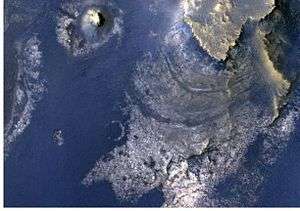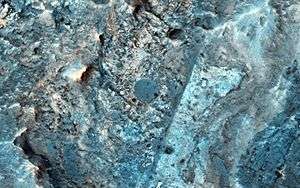McLaughlin (Martian crater)
Not to be confused with McLaughlin (Lunar crater).
 | |
| Planet | Mars |
|---|---|
| Region | Oxia Palus quadrangle |
| Coordinates | 21°54′N 337°38′E / 21.9°N 337.63°ECoordinates: 21°54′N 337°38′E / 21.9°N 337.63°E |
| Diameter | 90.92 km (56.50 mi)[1] |
| Depth | 2.2 km (1.4 mi)[2] |
| Eponym | Dean B. McLaughlin, American astronomer (1901-1965). (IAU, 1973).[1] |
McLaughlin Crater is an old crater in the Oxia Palus quadrangle of Mars, located at 21°54′N 337°38′E / 21.9°N 337.63°E. It is 90.92 km (56.50 mi)[1] in diameter and 2.2 km (1.4 mi)[2] deep. The crater was named after Dean B. McLaughlin, an American astronomer (1901-1965).[3][4] The Mars Reconnaissance Orbiter has found evidence that the water came from beneath the surface between 3.7 billion and 4 billion years ago and remained long enough to make carbonate-related clay minerals found in layers.[2][5] McLaughlin Crater, one of the deepest craters on Mars, contains Mg-Fe clays and carbonates that probably formed in a groundwater-fed alkaline lake. This type of lake could have had a massive biosphere of microscopic organisms.[6]

(released 14 January 2016).
See also
References
- 1 2 3 4 IAU Staff (17 November 2010). "McLaughlin - Crater, Mars, 3782". IAU. Retrieved 21 January 2013.
- 1 2 3 4 Choi, Charles Q. (20 January 2013). "Giant Mars Crater Shows Evidence of Ancient Lake". Space.com. Retrieved 21 January 2013.
- ↑ name="IAU-20101117"
- ↑ http://planetarynames.wr.usgs.gov/
- ↑ http://www.jpl.nasa.gov/news/news.php?release=2013-028
- ↑ Michalski,J., J. Cuadros, P. Niles, J. Parnell, A. Rogers, S. Wright. 2013. Groundwater activity on Mars and implications for a deep biosphere. Nature geoscience:6, 133–138.
This article is issued from Wikipedia - version of the 10/19/2016. The text is available under the Creative Commons Attribution/Share Alike but additional terms may apply for the media files.